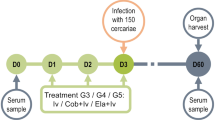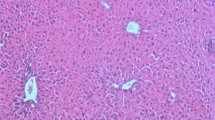Abstract
The susceptibility of two Venezuelan (YT and SM) and one Brazilian (BH) strain ofSchistosoma mansoni to single oral doses of praziquantel (Pz; 250 or 500 mg/kg), oxamniquine (Ox; 40, 60, or 100 mg/kg) or to low-dose combinations of both drugs (33 mg/kg Pz and 25 mg/kg Ox; 66 mg/kg Pz and 12.5 mg/kg Ox; 250 mg/kg Pz and 40 mg/kg Ox) was experimentally evaluated in mice. At lower doses of either drug, adult worms of the SM isolate were less susceptible than those of the BH and YT isolates. However, no difference in liver or intestinal egg counts (IECs) could be detected among the isolates after this treatment. At such doses, Pz was better than Ox at reducing IECs. In spite of lowered IECs, eggs continued to accumulate in the liver after Ox treatment. At higher individual doses or following treatment with low-dose combinations of both drugs, no difference in susceptibility could be detected among the parasite isolates. Under such conditions, oviposition was drastically reduced in all three isolates. We confirm that Ox preferentially kills male parasites and present for the first time evidence for the preferential killing of female worms by Pz. We propose that the synergistic effect obtained in the present study and in other investigations using low-dose combinations of both drugs may be due to the preferential cytotoxicity of each drug against a different parasite sex.
Similar content being viewed by others
References
Becker B, Mehlhorn H, Andrews P, Thomas H, Eckert J (1980) Light and electron microscopic studies on the effect of praziquantel onSchistosoma mansoni, Dicrocoelium dendriticum, andFasciola hepatica (Trematoda) in vitro. Z Parasitenkd 63:113–128
Branchini MLM, Pedro RJ, Dias LCS, Deberaldini ER (1982) Double blind clinical trial comparing praziquantel with oxamniquine in the treatment of patients with schistosomiasis mansoni. Rev Inst Med Trop São Paulo 24:315–321
Brindley PJ, Sher A (1987) The chemotherapeutic effect of praziquantel againstSchistosoma mansoni is dependent on host antibody response. J Immunol 139:215–220
Camargo S (1982) Tratamento com praziquantel de portadores de esquistosomosse, en area endemica, con persistencia de positividade apos succesivas administraçoes de oxamniquine. Rev Inst Med Trop São Paulo 24:180–187
Cheever AW (1968) Conditions affecting the accuracy of potassium hydroxide digestion techniques for countingSchistosoma mansoni eggs in tissues. Bull WHO 39:328–331
Coles GC, Mutehi WT, Kinoti GK, Bruce JI, Katz N (1987) Tolerance of KenyanSchistosoma mansoni to oxamniquine. Trans R Soc Trop Med Hyg 81:782–785
Crawford KA, Bruce JI, Bueding E (1980) Effects of the schistosomicide amoscanate in mice and primates infected withSchistosoma mekongi. Malacol Rev [Suppl 2]:181–193
Cunha A (1982) A avaliação terapêutica da oxamniquine na esquistosomosse mansoni humana pelo método do oograma por biopsia de mucosa rectal. Rev Inst Med Trop São Paulo 24:88–94
Dias LCS, Pedro RJ, Deberaldini ER (1982) Use of praziquantel in patients with schistosomiasis mansoni previously treated with oxamniquine and/or hycanthone: resistance ofSchistosoma mansoni to schistosomicidal agents. Trans R Soc Trop Med Hyg 76:652–659
Dias LCS, Bruce JI, Coles GC (1988) Variation in response ofSchistosoma mansoni strains to schistosomicides. Rev Inst Med Trop São Paulo 30:81–85
Erasmus DA, Davies TW (1979)Schistosoma mansoni andS. haematobium: calcium metabolism of the vitelline cell. Exp Parasitol 47:91–106
Flisser A, Delgado VS, McLaren DJ (1989)Schistosoma mansoni: enhanced efficacy of praziquantel treatment in immune mice. Parasite Immunol 11:319–328
Foster R (1973) The preclinical development of oxamniquine. Rev Inst Med Trop São Paulo 15 [Suppl 1]:1–9
Foster R (1987) A review of clinical experience with oxamniquine. Trans R Soc Trop Med Hyg 81:55–59
Gönnert R, Andrews P (1977) Praziquantel, a new broad-spectrum antischistosomal agent. Z Parasitenkd 52:129–150
Jaimes Berti J, Schmidt Dommerque F (1981) Ensayo terapéutico con praziquantel en casos de schistosomiasis mansoni, resistentes al oxamniquine. Trib Med (Venezuela) 54:6–7
Jaimes Berti J, Paez de Molina B, Schmidt Dommerque F (1979) Tratamiento de la esquistosomiasis mansoni. Estudio comparativo entre el praziquantel y el oxamniquine. Trib Med (Venezuela) 50:12–13
Katz N, Rocha RS, Lambertucci JR, Greco DB, Pedroso ERP, Rocha MOC, Flan S (1983) Clinical trial with oxamniquine and praziquantel in the acute and chronic phases of schistosomiasis mansoni. Rev Inst Med Trop São Paulo 25:173–177
Mehlhorn H, Becker B, Andrews P, Thomas H, Frenkel JK (1981) In vivo and in vitro experiments on the effects of praziquantel onSchistosoma mansoni. A light and electron microscopic study. Arzneimittelforschung 31:544–554
Pedro RJ, Dias LCS, Amato Neto V, Carvalho SA (1980) Observations on the treatment of mansoni schistosomiasis with oxamniquine: efficacy in children and in persistent salmonellosis; resistance of a strain ofSchistosoma mansoni; hepatic toxicity and neurological side effects. Rev Inst Med Trop São Paulo 22 [Suppl 4]:32–36
Pellegrino J, Lima-Costa FF, Carlos MA, Mello RT (1977) Experimental chemotherapy ofSchistosoma mansoni: XIII. Activity of praziquantel, an isoquinoline-pyrazino derivative, on mice, hamsters and cebus monkeys. Z Parasitenkd 52:151–168
Popiel I, Erasmus DA (1984)Schistosoma mansoni: ultrastructure of adults from mice treated with oxamniquine. Exp Parasitol 58:254–262
Popiel I, Cioli D, Erasmus DA (1984) The morphology and reproductive status of femaleSchistosoma mansoni following separation from male worms. Int J Parasitol 14:183–190
Pugh RNH, Teesdale CH (1983) Synergy of concurrent low dose oxamniquine and praziquantel in schistosomiasis. BMJ 287:877–878
Rugemalila JB, Asila J, Chimbe A (1984) Randomized comparative trials of single doses of the newer antischistosomal drugs at Mwanza, Tanzania: I. Praziquantel and oxamniquine for the treatment of schistosomiasis mansoni. J Trop Med Hyg 87:231–235
Shaw MK, Erasmus DA (1982)Schistosoma mansoni: the presence and ultrastructure of vitelline cells in adult males. J Helminthol 56:51–53
Shaw MK, Erasmus DA (1983)Schistosoma mansoni: the effects of a subcurative dose of praziquantel on the ultrastructure of worms in vivo. Z Parasitenkd 69:73–90
Shaw MK, Erasmus DA (1988)Schistosoma mansoni: praziquantel-induced changes to the female reproductive system. Exp Parasitol 65:31–42
Smithers SR, Terry RJ (1965) Infection of laboratory hosts with cercariae ofSchistosoma mansoni and the recovery of adult worms. Parasitology 55:695–700
Webbe G, James C (1977) A comparison of the susceptibility to praziquantel ofSchistosoma haematobium, S. japonicum, S. mansoni, S. intercalatum andS. matheei in hamster. Z Parasitenkd 52:169–177
World Health Organization (1984) Report of the Scientific Working Group on the biochemistry and chemotherapy of schistosomiasis. TDR/SCH-SWG Publication 5/84.1. WHO, Geneva
Xiao SH, Yu YG, Wang CY, Jiao PY, Yuan XJ, Liang Y (1981) The uptake and distribution of [3H]-pyquiton inSchistosoma japonicum. Chung Kuo Yao Li Hsueh Pao 16:488–493
Author information
Authors and Affiliations
Rights and permissions
About this article
Cite this article
Delgado, V.S., Suárez, D.P., Cesari, I.M. et al. Experimental chemotherapy ofSchistosoma mansoni with praziquantel and oxamniquine: differential effect of single or combined formulations of drugs on various strains and on both sexes of the parasite. Parasitol Res 78, 648–654 (1992). https://doi.org/10.1007/BF00931515
Accepted:
Issue Date:
DOI: https://doi.org/10.1007/BF00931515




